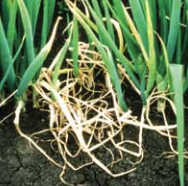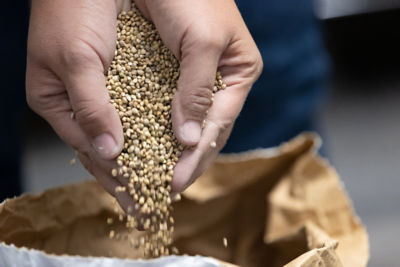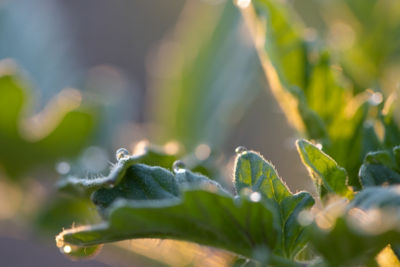Causal Agent
Sclerotium cepivorum
Distribution
Worldwide
Symptoms
This disease can be one of the most damaging on onions with the first symptoms including yellowing, wilting and dropping of the older leaves. As the fungus invades the root system and basal plate it causes a rot, which eventually results in the collapse of the foliage. A soft rot gradually develops in the bulb and a thick white mycelial growth develops on the base of the bulb. Numerous sclerotia form on the diseased tissues. This disease usually appears on groups of plants in the field that are often widely spaced. However, large groups of plants may die suddenly when the fungus is abundant in the soil and conditions are favorable for disease.
 Localized plant death in the field.
Localized plant death in the field.
 White mycelia and small black sclerotia on mature bulbs.
White mycelia and small black sclerotia on mature bulbs.
Conditions for Development
This disease can be one of the most damaging on onions with the first symptoms including yellowing, wilting and dropping of the older leaves. As the fungus invades the root system and basal plate it causes a rot, which eventually results in the collapse of the foliage. A soft rot gradually develops in the bulb and a thick white mycelial growth develops on the base of the bulb. Numerous sclerotia form on the diseased tissues. This disease usually appears on groups of plants in the field that are often widely spaced. However, large groups of plants may die suddenly when the fungus is abundant in the soil and conditions are favorable for disease.
Control
White rot is difficult to control. Use healthy sets of plants and avoid introducing infested soil and water into the field. If the disease is just beginning in the field, removing and disposing of infected plants will help reduce the amount of the fungus in the soil. Spot treatments of soil with fumigants or fungicides may provide some control when the disease is limited in the field. Flooding, soil solarization and the use of natural and synthetic sclerotia germination stimulants have been shown to reduce sclerotia populations in the soil, and therefore may reduce losses from this disease.




